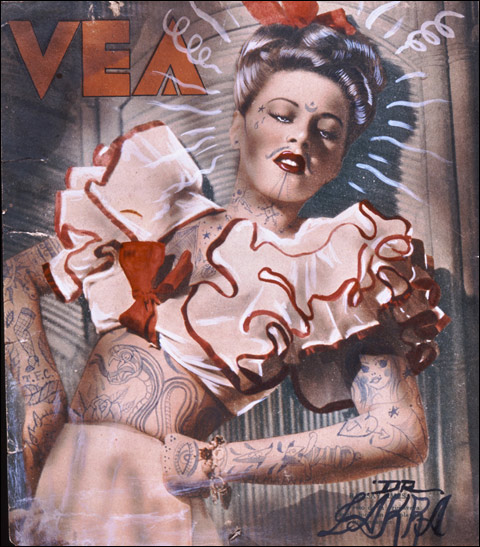
UNTITLED (OLANES) Dr. Lakra’s drawings are rebellious in the way of high-school bathroom graffiti, or a kid drawing moustaches on pictures of famous women. |
They say Dr. Lakra got his pen name from the doctor’s bag he carried around when he first began tattooing, two decades ago. “Lakra” puns on the Spanish word “lacra,” meaning scar or blemish, but it’s also slang for “delinquent” or “scumbag.” And it suits an artist whose new show at the Institute of Contemporary Art — billed as his first solo exhibition in the United States — features dozens of vintage magazine images of pin-up girls and masked Mexican lucha libre wrestlers and even a head of state, all covered with imitation tattoos of skulls and snakes, devils and clowns, knives and swastikas, gang signs and roses, Madonnas and go-go girls.“I’m always trying to deal with this basic primal urge,” Dr. Lakra has explained. “Primitive instincts like sex, violence, graffiti are all innate in human beings and not tied to one culture.”
Dr. Lakra’s drawings are rebellious in the way of high-school bathroom graffiti, or a kid filling up the margins of a textbook with doodles and drawing moustaches on pictures of famous women. The results are fast, trashy, funny, adolescent, naughty, and super-hip — a blend of bad-ass-guy fantasy and sweet nostalgia.
He was born Jerónimo López Ramírez in Oaxaca in 1972. His travels have taken him to Mexico City, Berlin (where he squatted), San Francisco (where he made money tattooing gang members and worked on a prison-literacy program), Mexico City again, and then back to Oaxaca, where he now lives. He’s studied traditional tattooing techniques in Thailand and the Philippines. Vice magazine reports that his chest is tattooed with “a Christ face with demons dancing around and peeing all over his face.”
But don’t let the street cred of this “self-taught illustrator and tattoo artist” blind you to his avant-garde bona fides. In the late 1980s, he was the odd scribbler among a bunch of conceptual sculptors when he joined a regular Friday salon in the Mexico City home of Gabriel Orozco (who had a retrospective at New York’s Museum of Modern Art this past winter) with Abraham Cruzvillegas, Gabriel Kuri, and Damián Ortega (who had a retrospective at the ICA last fall). And the New York Times has described his artist and museum-founder dad, Francisco Toledo, as “reigning elder of the modern-art world of Oaxaca” and “one of Mexico’s most original and versatile artists.” You don’t have to be Sigmund Freud to note similarities between Dr. Lakra’s imagery and his dad’s hallucinatory, folksy, mythic Modernist paintings and prints of frogs, iguanas, snakes, bugs, rabbits, and naked ladies. Sex and violence surface frequently in Toledo’s work — check out the 1969 etching of a caged naked woman being pawed by a lion with an erection.